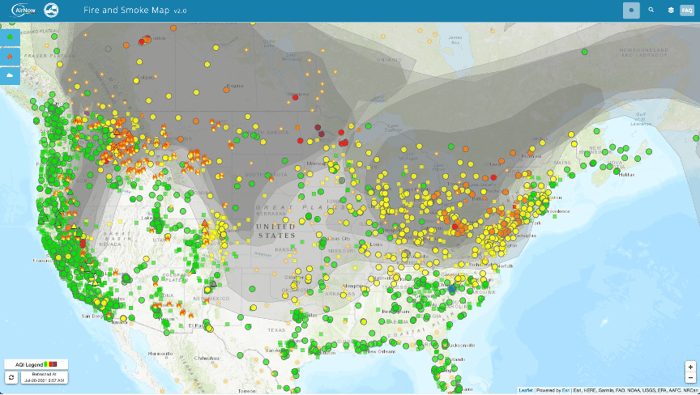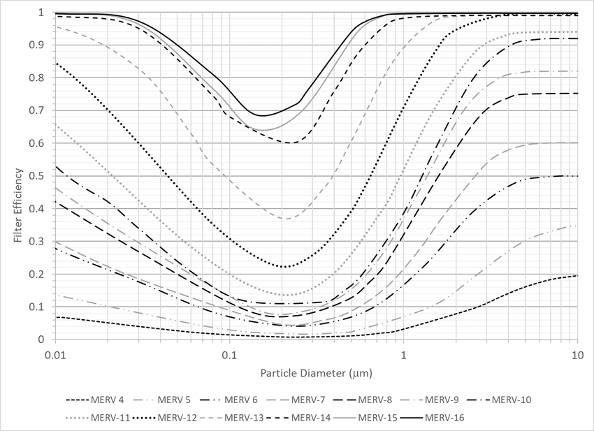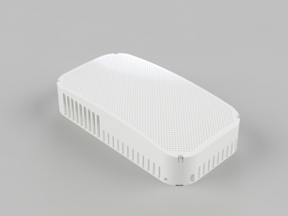Introduction
Indoor air quality (IAQ) has fascinated many but remained largely on the periphery of most property managers. One need only examine the technology infrastructure within a typical commercial building to recognize that IAQ is neither prioritized nor valued historically.
If you happen to be in a Platinum LEED Building, it is possible that the property management has advertised the active monitoring of carbon dioxide (CO2) levels. Don’t expect, however, the real-time monitoring of more advanced IAQ metrics such as particulate matter (PM), Volatile Organic Compounds (VOCs), Ozone, or Carbon Monoxide (CO). Your building is blind to monitoring such airborne pollutants.
New buildings aren’t immune to this problem. If you leased space in a new Class A office building that opened just this week, you’re still out of luck. The Building Automation System (BAS) in the new office building wasn’t designed to monitor advanced IAQ metrics. It is functionally obsolete, even though it is only a week old.
Everyone Now Cares About IAQ
IAQ has transitioned from tangential interest to main-stream focus. In the current COVID-19 environment, the fear of what individuals may be breathing has paralyzed many building owners and operators as they grapple with the immediate threats posed by harmful airborne virus pathogens.
The public has become hyper-sensitized to airborne threats. Masks offer an ever-present reminder of people’s concerns about what they may be breathing. Re-population plans have increasingly sought to integrate real-time airborne monitoring into modern building management. Retail, schools, hospitality, government, businesses, and other public buildings are looking for real-time IAQ data to mitigate risks posed by airborne pollutants.
Real-time IAQ monitoring has great appeal because it makes visible what is presently unseen.
IAQ Products Cannot Keep Up with the IAQ Market
Narrow, purpose-built IAQ products have failed to keep up with the breadth of new IAQ applications. Diverse applications such as (1) air filtration efficacy, (2) Needlepoint Bi-Polar Ionization (NPBI) efficacy, and (3) IAQ monitoring in schools place unique demands on the IAQ product. An IAQ product struggles in this diverse application environment because one size surely does not fit all. This is not surprising because a product-mentality inherently targets a single vertical market and struggles to expand seamlessly to adjacent markets.
IAQ products are inherently limited because their sensor specifications and capabilities are frozen during production; desired modifications would require re-engineering, re-qualification, and re-certification. This prohibits an agile IAQ technology roadmap that can accommodate rapidly evolving IAQ applications demanded by today’s dynamic building management strategies.
IAQ Platform Pioneered to Keep Pace with Dynamic IAQ Market
Senseware has built a true IAQ platform with our high-velocity modular IoT hardware architecture. It is specifically designed to combat the IAQ industry’s low-velocity problem, which relies on too many manual development stages to produce unique IAQ hardware solutions.
Senseware’s high-velocity modular IoT hardware architecture is rooted on the same foundational industrial design principles of modularity that enabled Sony to produce more than 250 variations of its Walkman-type products during a 10-year period. We’ve done the same to the IAQ market to meet the needs of a diverse set of IAQ applications.
Our IoT modularity provides major advantages. We can:
1. Deliver greater IAQ hardware variations at mass-produced prices
2. Upgrade IAQ sensors faster than the rest of the industry
3. Reduce the time to market for new hardware introductions.
Our partners will be assured of remaining ahead of the technological curve in all things IAQ.
We explore three diverse IAQ applications that demonstrate the ability and flexibility of our IAQ Platform to give the market access to the latest IAQ sensor technology with little to no development time, adapting seamlessly to an IAQ application’s unique data need.
1. Air Filtration Efficacy
Wildfires and associated emissions of particulate matter pose significant environmental and health concerns. There is clear evidence that wildfire smoke, which includes particulate matter with 2.5 μm diameter (PM2.5), is linked to respiratory health implications, morbidity, and mortality. This issue is not confined to the west coast, where increased wildfire frequency and intensity have been observed.
The comparative real-time data from two east coast buildings demonstrate the relative severity of the building management issue to west coast wildfire events (see Figure 1, 2, and 3). Both east coast buildings were outfitted with wireless IAQ devices that incorporated conventional PM2.5 sensors.
Fig 1 – Fire and Smoke Map on 07/20/2021 via Airnow.gov showing how wildfires in CA can impact Air Quality all the way to the East Coast
Figure 1 shows the Air Quality over the USA as a result of the wildfires in California and other western states. The air pollution generated by the wildfires impacts the air quality all the way to the east coast, as shown on Figures 2 and 3. The PM2.5 levels measured in the outside air jump starting on July 4th when the air pollution reaches the east coast (Blue bars on Figures 2 and 3).
Fig 2 – PM2.5 readings from 6/24/21 to 7/23/21 in a Building on the East Coast with limited air filtration. Blue is Outside Air; Black is Supply Air.
 Fig 3 – PM2.5 readings from 6/24/21 to 7/23/21 in a Building on the East Coast with a MERV-15 filter on the Outside Air. Blue is Outside Air; Black is Supply Air.
Fig 3 – PM2.5 readings from 6/24/21 to 7/23/21 in a Building on the East Coast with a MERV-15 filter on the Outside Air. Blue is Outside Air; Black is Supply Air.
The difference in IAQ between the two east coast buildings is striking (black bars on Figures 2 and 3). The first building (Figure 2) featured limited air filtration, while the second building (Figure 3) effectively combatted the west coast wildfire event through systematic air filtration governing the outside air intake vents. The real-time IAQ data enabled the building management company to quantify the effectiveness of their air filtration program.
A common response to the COVID-19 pandemic has been to upgrade the level of air filtration to MERV 13-15 filters. The main feature of such higher-rated MERV 13-15 filters is their increased efficiency in filtering sub-micron particulates.

Fig 4 - Particle filtration efficiency vs particle diameter for a range of MERV filter ratings[1].
[1]Dols, William & Polidoro, Brian & Poppendieck, Dustin & Emmerich, Steven. (2020). A Tool to Model the Fate and Transport of Indoor Microbiological Aerosols (FaTIMA). https://nvlpubs.nist.gov/nistpubs/TechnicalNotes/NIST.TN.2095.pdf
Monitoring the efficacy of improved air filtration using MERV 13-15 filters requires next-generation particulate matter sensors. Notably, industry standard PM2.5 sensors used by most IAQ products were released in 2017; these 5-year-old sensors will not provide sufficient sub-micron particulate matter data to assess the efficacy of installed MERV 13-15 filters. IAQ products are stuck in the past technologically.
Senseware’s IAQ Platform enables upgrading of PM2.5 sensors with next-generation PM1.0 sensors before the rest of the industry. These improved PM1.0 sensors will enable building managers to monitor the sub-micron particle filtration efficiency of installed MERV 13-15 filters.
As this IAQ application demonstrates, modern building management is increasingly reliant on next-generation particulate matter sensors to monitor and assess the efficacy of a building’s air filtration system. They cannot afford to wait for conventional IAQ product upgrade cycles.
2. Needlepoint Bi-Polar Ionization (NPBI) Efficacy
Clean-air matters and various mitigation efforts have been adopted. Many buildings have installed Needlepoint Bi-Polar Ionization (NPBI) in their desire to keep their air clean. NBPI systems claim to safely clean indoor air by leveraging an electronic charge to create a high concentration of positive and negative ions. These ions are purported to travel through the air continuously seeking out and attaching to potentially harmful contaminant particles for removal from the air. Much research on NPBI effectiveness remains outstanding. The topic is certainly controversial.
The CDC’s position on NBPI states that:
“Consumers should request efficacy performance data that quantitatively demonstrates a clear protective benefit under conditions consistent with those for which the consumer is intending to apply the technology.”
To answer this most pressing question, Senseware introduced a new category of indoor air quality product, IAQ-I, which combines an ion sensor with a particulate matter sensor and volatile organic compounds sensor. The stated purpose of the IAQ-I product is to measure the relative presence of ions in the space as compared to the level of air impurities.

Fig 5 – Senseware IAQ-I, which includes an ion sensor and a sub-micron PM sensor, among others
Figures 6, 7, and 8 show some initial analysis enabled by real-time data generated via IAQ-I. Figure 6 shows the relative impact on air impurities in a sample room where ions were generated. A decrease in ions can be observed when PM2.5 and TVOC levels increase, which appears to suggest that the ions are interacting with the airborne contaminants and start decreasing their observed levels.
Fig 6 – Ions Level (blue), TVOC (green), and PM2.5 levels (black) as measured by an IAQ-I device
Figure 7 shows a sharp reduction in ions when TVOC is released via a cleaning spray in a room with an ion generator before going back to their initial level once the TVOC level starts reducing. The PM2.5 levels do not seem to be affected at all.

Fig 7 – Ions Levels (black), TVOC (blue), and PM2.5 levels (red) as measures by an IAQ-I device when TVOC are released
Figure 8 shows the average readings in 2 different rooms of the same office space, served by the same HVAC unit. One of the rooms (blue) has a GPS ion generator in the room while the other room (black) does not.
Fig 8 – PM2.5 levels in 2 rooms in an office space. One (blue) has an ion generator in the room while the other room (black) does not
While further analysis of the utility of data from the IAQ-I product will be needed to achieve the ultimate goal of enabling modern building management to assess the effectiveness of NPBI air purification systems, what is clear is that Senseware’s IAQ Platform enabled the creation of a new category of indoor air quality product, IAQ-I, to respond to the needs of a new IAQ application.
3. Indoor Air Quality in Schools
Historically, CO2 represents the most familiar IAQ metric known to the HVAC industry. A study published in Environmental Health Perspectives [2] found cognitive functions suffered when exposed to elevated CO2 levels. When a room feels “stuffy” concentration levels suffer. It has been well established that cognitive functions improve with better ventilation control that addresses high CO2 levels. Interest in active measurement of CO2 levels has therefore increased.
For many school administrators, it is their first time deeply considering air quality, and the recommendations have come in contrast to typical operating procedures. In California, for example, Assembly Bill No. 841 codified the need to ensure proper ventilation throughout the school year through the equipping of all classrooms with active CO2 monitors. The consequences of outdated or inadequate HVAC can be shocking.
After installing IAQ monitors in several classrooms in an Atlanta area school, we measured CO2 levels throughout the day (see Figure 9). We found that levels in some rooms reached peak contamination levels of 4,000 ppm. An acceptable target for peak CO2 levels in a classroom environment would be around 1,000 ppm. When levels reach 2,000 ppm, we consider that alarming and an impediment to student learning. CO2 levels were high enough in this school to cause physical side effects including headaches, insomnia and nausea.
[2] Joseph G. Allen, Piers MacNaughton, Usha Satish, Suresh Santanam, Jose Vallarino, and John D. Spengler. Associations of Cognitive Function Scores with Carbon Dioxide, Ventilation, and Volatile Organic Compound Exposures in Office Workers: A Controlled Exposure Study of Green and Conventional Office Environments. https://doi.org/10.1289/ehp.1510037

Fig 9 – High CO2 concentration levels in some classrooms
Outfitting school classroom with active CO2 monitors represents a good first step for schools into IAQ. CO2 isn’t the only potential issue, unfortunately. One of the side effects of COVID-19 mitigation efforts is the effect of “overcleaning.” While more “cleaning” is desired by the general public and administrators, unintended consequences can occur.

Fig 10 – TVOC levels in some poorly ventilated classrooms due to overcleaning
As this example demonstrates (see Figure 10), extremely high VOC levels can result through overcleaning. Safe levels of TVOC are typically below 220ppb. In this example, levels stayed in the tens of thousands for several hours.
This demonstrates yet again the importance of gaining visibility into elevated levels of airborne contaminants. Where school facility personnel desire to gain additional insights into the impact of COVID-19 mitigation efforts, a VOC sensor can be added to the CO2 sensor in an augmented IAQ monitoring device.
Notably, a true IAQ Platform provides full customization such that the IAQ monitoring device is outfitted only with the set of IAQ sensors needed; it is not cluttered with additional unneeded IAQ sensors. This tailored approach ensures that the IAQ solution conforms to the school’s particular IAQ specification, while also ensuring that a built-in upgrade path exists as IAQ application needs change.
Conclusion
The IAQ market has expanded rapidly as different building segments (e.g., retail, schools, hospitality, government, businesses) look to mitigate risks posed by airborne pollutants. Their unique interests have spawned unique IAQ applications that would benefit from a flexible IAQ approach. The IAQ market is bigger than a single IAQ product and requires a true IAQ Platform. This will become increasingly true as more organizations receive and recognize the benefit of real-time IAQ data in producing various forms of operational efficiency.
Stay In The Know
Subscribe to our newsletter to get the latest on indoor air quality trends and best practices.

